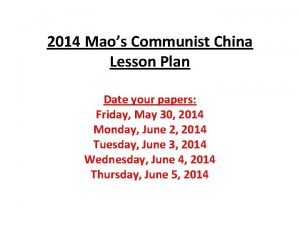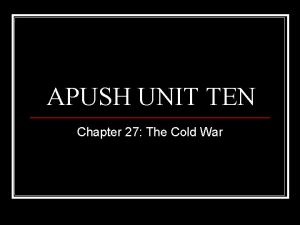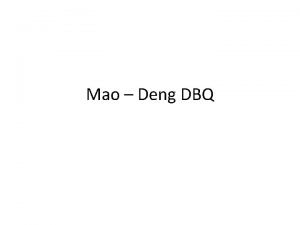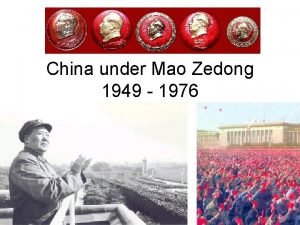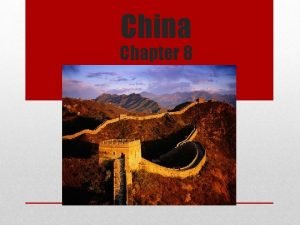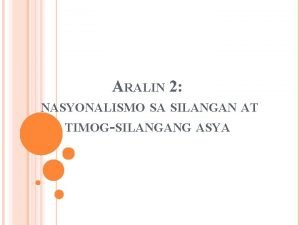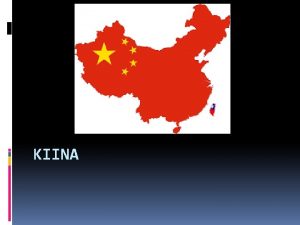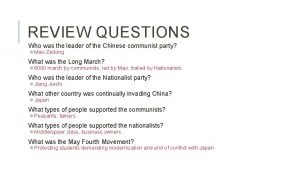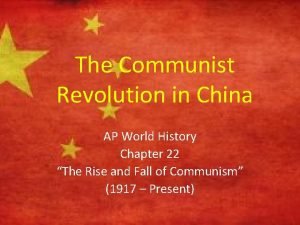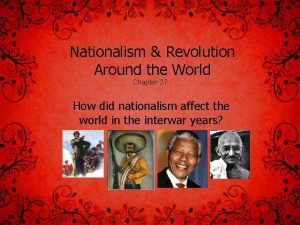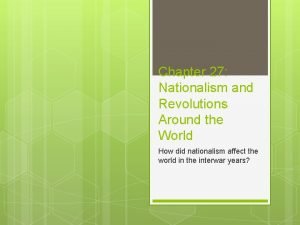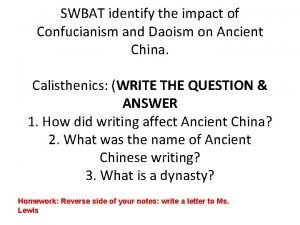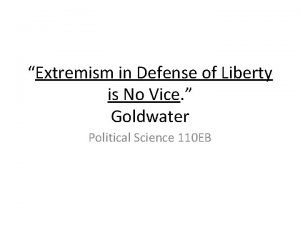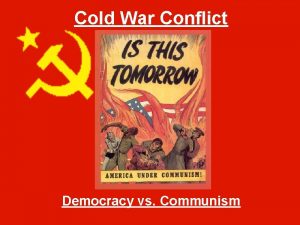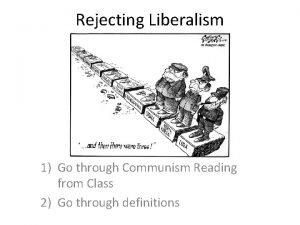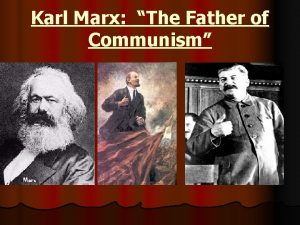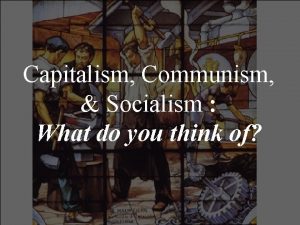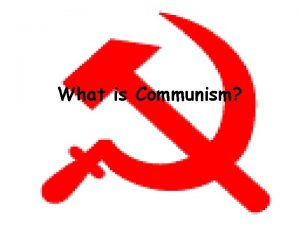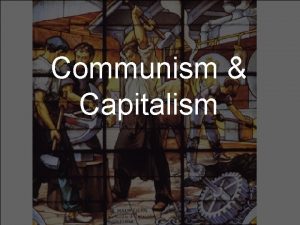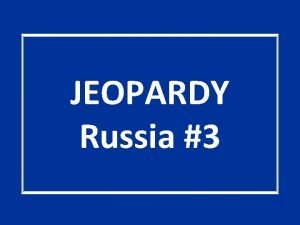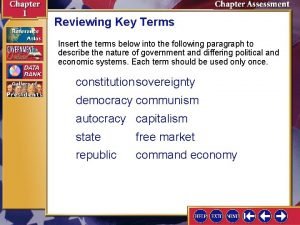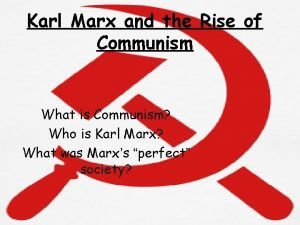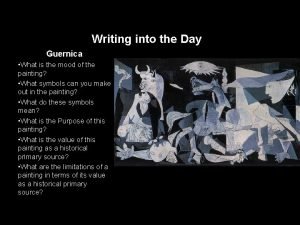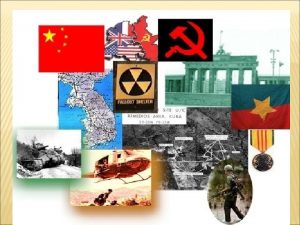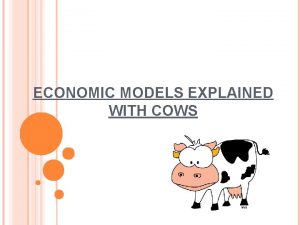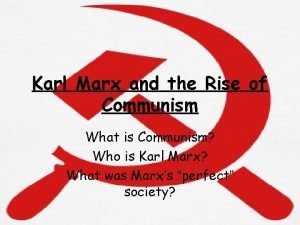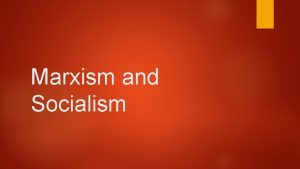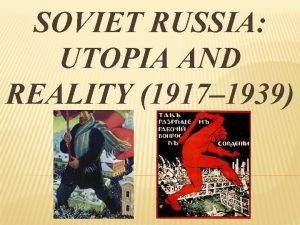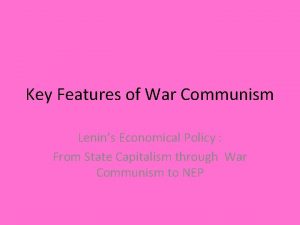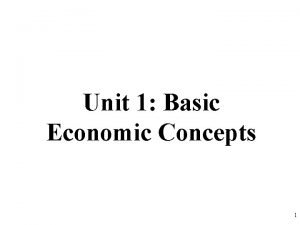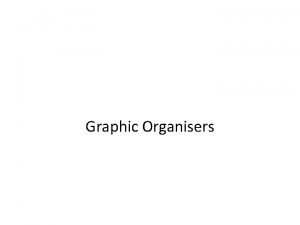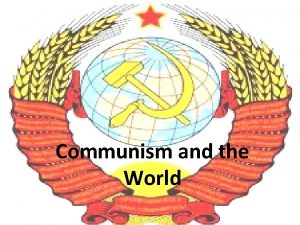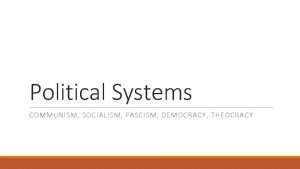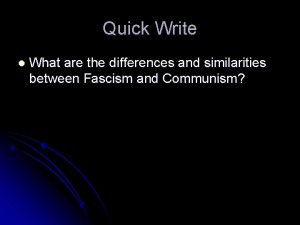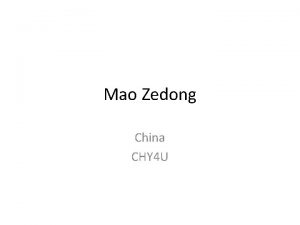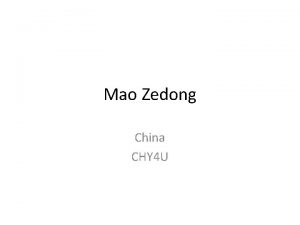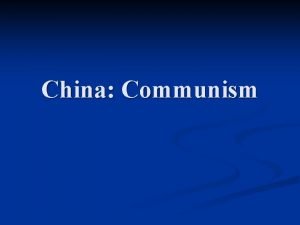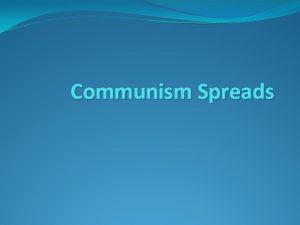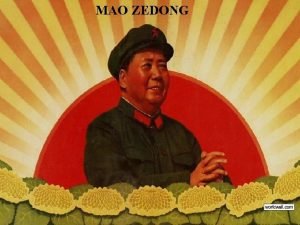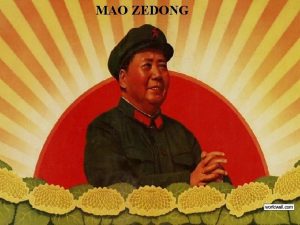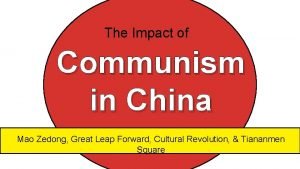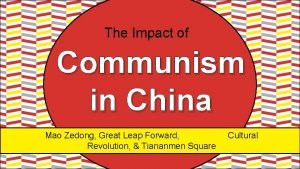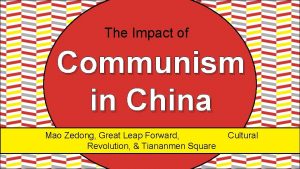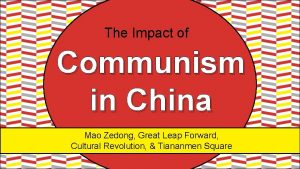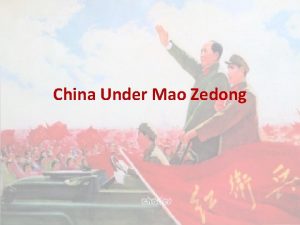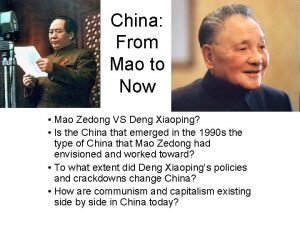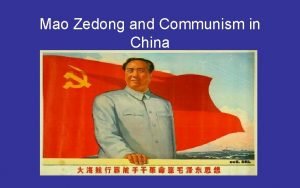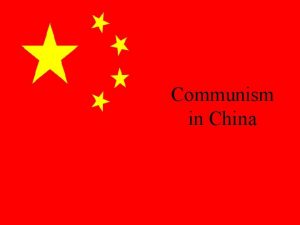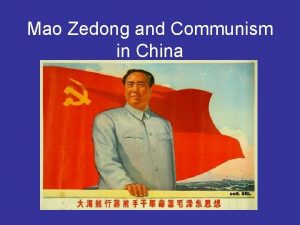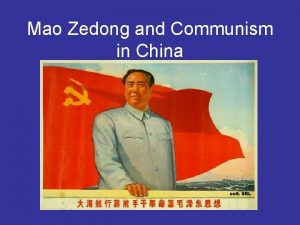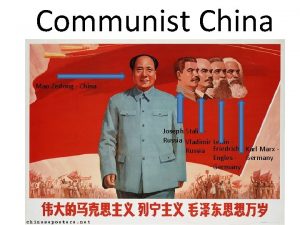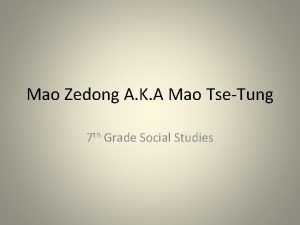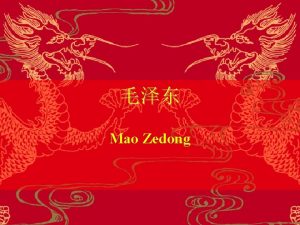The Impact of Communism in China Mao Zedong







































- Slides: 39

The Impact of Communism in China Mao Zedong, Great Leap Forward, Revolution, & Tiananmen Square Cultural

Standards SS 7 H 3 The student will analyze continuity and change in Southern and Eastern Asia leading to the 21 st century. d. Describe the impact of Communism in China in terms of Mao Zedong, the Great Leap Forward, the Cultural Revolution, and Tiananmen Square.

Teachers • • • Print off the following page for each student. Before the presentation, have the students make predictions about each term and discuss as a class. Have the students complete the actual definitions while discussing the presentation (definitions are in the notes). *Discuss definitions afterwards to make sure that everyone wrote down sufficient info.


The Impact of Communism in China Mao Zedong, Great Leap Forward, Revolution, & Tiananmen Square Cultural

Nationalism • In 1911, a group of nationalists had taken over China. • The Chinese Nationalist Party was able to overthrow the Qing Dynasty, which had been in power since the 1600 s. • Unfortunately, the new government was failing to provide for the Chinese people and many were living in poverty. • Many Chinese were angry and became interested in the Communist Revolution in Russia.

Communist Party • In 1921, a group of young men met in Shanghai to form the first Chinese Communist Party, headed by Mao Zedong. • The party promised to improve peasants’ living conditions and won the support of many Chinese people. • A civil war soon began between the Nationalists and Mao’s communist followers. • In 1933, Mao led over 600, 000 people on the Long March through the mountains for over 6, 000 miles to avoid being captured by the nationalist government.

"Revolution is not a dinner party, nor an essay, nor a painting, nor a piece of embroidery; it cannot be so refined, so leisurely and gentle, so temperate, kind, courteous, restrained and magnanimous. A revolution is an insurrection, an act of violence by which one class overthrows another. ” ~Mao Zedong 1927

The Long March Mao Zedong 1935

People’s Republic • The Communists and Nationalists had to call a truce during WWII as both were fighting to keep the Japanese out of China. • The civil war continued from 1946 to 1949, until the Communists, now called the Red Army, took control of China’s government. • On October 1, 1949, Mao declared the creation of the People’s Republic of China, a communist country. • Mao was appointed head of China’s government and had almost complete control over China. • He became popular with many Chinese people when he took land from wealthy citizens and gave it to peasants. • He wanted to improve living conditions for the poor.

Mao Zedong declares the founding of the People's Republic of China on October 1 st, 1949.

Great Leap Forward • Mao implemented a program in 1958 to organize all farms into collectives where large communes of about 25, 000 people farmed together under government supervision. • He believed this would speed China’s economic development, so the program was called the Great Leap Forward. • The Great Leap Forward was a disaster. • Chinese farmers did not like the government making all of the decisions and, because they no longer owned the land, they had little reason to work hard. • Droughts and floods damaged the food supply that year and made things even worse. • As a result, about 20 million people died from 1958 to 1960 during one of the largest famines in history.

Women working together during the Great Leap Forward.

Collective Farming 1959

The Great Famine

• Cultural Revolution The failures of the Great Leap forward made many Chinese lose confidence in Mao’s leadership. • In response, Map created the Cultural Revolution in 1966 to stop all opposition to the Chinese Communist Party. • He urged students to quit school and wage war on anyone who opposed communism. • The students were organized into an army known as the Red Guards. • They attacked, imprisoned, and even killed those suspected of not agreeing with Mao. • The Cultural Revolution created mass chaos in China for almost 10 years. • Many schools and factories were closed, and people were denied healthcare and transportation by the government.

Cover of an elementary school textbook – image shows 3 young Red Guards.

“Destroy the Old World” Cultural Revolution Propaganda Poster 1967

Cultural Revolution Propaganda Poster

Mao’s The Little Red Book This was a collection of excerpts from past speeches and publications. It was required for citizens to read, memorize, and carry this with them at all times.

New Leader • Mao Zedong died in 1976 and the Cultural Revolution finally ended. • China’s new leader, Deng Xiaoping, made many reforms to Mao’s rules, but the government still stuck to its communist roots. • He began to allow farmers to own their own land to make decisions about what they should grow. • He allowed some private businesses to open. • He opened China to foreign investments. • Unfortunately, the Chinese people were still not given basic human rights like freedom of speech and religion or the right to a fair trial.

Tiananmen Square • In 1989, communist governments were under siege in numerous places around the world. • Over 10, 000 Chinese students gathered to protest China’s corrupt communist government in Beijing’s Tiananmen Square. • They filled the square for seven weeks, peacefully speaking against communism and calling for a move toward democracy in China. • On June 4, 1989, the Chinese government soldiers and tanks into the square, killing hundreds of innocent people. • Countries around the world condemned this violence and began urging China to improve the human rights of its citizens.

Tiananmen Square, Beijing 1988

1989

Tanks Rolling In…





Teachers – Triangle Trivia Review Game • Put the students into pairs. • Display the next slide on the screen. • This should take about 2 -3 minutes if you want to set a timer. • *You can also have the students create their own triangle boards for any topic!

Your Task: • Turn to your elbow buddy. One of you should turn so that you cannot see the screen. • The partner that can see the screen is going to give clues for all of the words in triangle. • The other partner will try to guess all of the words in the time allowed. • If you don’t know a word, just say, “Pass!” • Keep track of your own points!

Triangle Trivia! Red Guard Describe each word for your partner! 3 points Long March 2 points Nationalism 1 point 1949 China 1 point Tiananmen Square 1 point

Triangle Trivia! Little Red Book Describe each word for your partner! 3 points Great Leap Forward 1989 2 points Communism 1 point Mao Zedong 1 point 2 points Cultural Revolution 1 point





Teachers Thank you for downloading this file. I hope you enjoy using it with your students, and I can’t wait to read your feedback in my TPT store! • For more social studies materials, please visit my store: http: //www. teacherspayteachers. com/Store/Brain-Wrinkles • I teach Language Arts and Social Studies in Georgia, so my products are aligned with Common Core (LA) and Georgia Performance Standards (SS). © Copyright 2013. Brain Wrinkles. All rights reserved. Permission is granted to copy pages specifically designed for student or teacher use by the original purchaser or licensee. The reproduction of any other part of this product is strictly prohibited. Copying any part of this product and placing it on the Internet in any form (even a personal/classroom website) is strictly forbidden. Doing so makes it possible for an Internet search to make the document available on the Internet, free of charge, and is a violation of the Digital Millennium Copyright Act (DMCA).

Credits: Photos were found via Creative Commons and labeled for reuse. • Fonts: • Backgrounds & Graphics: *The graphics used in this item are copyrighted and may not be used for your own commercial projects or given away to anyone else.
 Mao zedong lesson plan
Mao zedong lesson plan Allen ginsberg apush
Allen ginsberg apush Mao zedong vs deng xiaoping
Mao zedong vs deng xiaoping Mao zedong outline
Mao zedong outline Sun yat sen and mao zedong
Sun yat sen and mao zedong Nasyonalismo sa germany
Nasyonalismo sa germany Tiananmenin verilöyly
Tiananmenin verilöyly Mao mao
Mao mao Chinese communist party ap world history
Chinese communist party ap world history When did mao take over china
When did mao take over china When did mao take over china
When did mao take over china What was the impact of daoism in ancient china
What was the impact of daoism in ancient china Extremism in the defense of liberty is no vice
Extremism in the defense of liberty is no vice Cold war democracy vs communism
Cold war democracy vs communism Utopian socialsim
Utopian socialsim What are the characteristics of communism
What are the characteristics of communism Communism
Communism Site:slidetodoc.com
Site:slidetodoc.com Communist meaning
Communist meaning Feudalism capitalism socialism communism
Feudalism capitalism socialism communism Communism vs socialism
Communism vs socialism Reviewing key terms
Reviewing key terms Communism
Communism Fascism vs communism
Fascism vs communism Communism cold war
Communism cold war Collectivism economics
Collectivism economics Cows economic models
Cows economic models Capitalism communism socialism fascism
Capitalism communism socialism fascism Utopia and communism
Utopia and communism Communism vs socialism
Communism vs socialism Socialism capitalism communism fascism
Socialism capitalism communism fascism Nazism vs communism
Nazism vs communism Scissors crisis
Scissors crisis Examples of communism
Examples of communism Stair step graphic organizer
Stair step graphic organizer Domino theory map
Domino theory map Socialism vs communism
Socialism vs communism Fascism vs communism
Fascism vs communism Trotskyism vs communism
Trotskyism vs communism Similarities and differences of fascism
Similarities and differences of fascism
